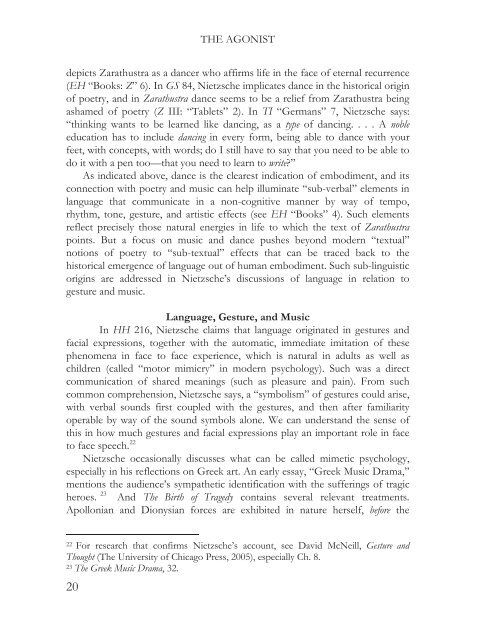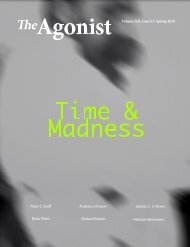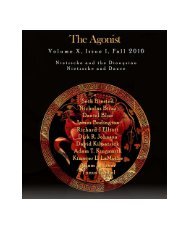Volume XI, Issue II, Spring 2018
Create successful ePaper yourself
Turn your PDF publications into a flip-book with our unique Google optimized e-Paper software.
THE AGONIST<br />
depicts Zarathustra as a dancer who affirms life in the face of eternal recurrence<br />
(EH “Books: Z” 6). In GS 84, Nietzsche implicates dance in the historical origin<br />
of poetry, and in Zarathustra dance seems to be a relief from Zarathustra being<br />
ashamed of poetry (Z <strong>II</strong>I: “Tablets” 2). In TI “Germans” 7, Nietzsche says:<br />
“thinking wants to be learned like dancing, as a type of dancing. . . . A noble<br />
education has to include dancing in every form, being able to dance with your<br />
feet, with concepts, with words; do I still have to say that you need to be able to<br />
do it with a pen too—that you need to learn to write?”<br />
As indicated above, dance is the clearest indication of embodiment, and its<br />
connection with poetry and music can help illuminate “sub-verbal” elements in<br />
language that communicate in a non-cognitive manner by way of tempo,<br />
rhythm, tone, gesture, and artistic effects (see EH “Books” 4). Such elements<br />
reflect precisely those natural energies in life to which the text of Zarathustra<br />
points. But a focus on music and dance pushes beyond modern “textual”<br />
notions of poetry to “sub-textual” effects that can be traced back to the<br />
historical emergence of language out of human embodiment. Such sub-linguistic<br />
origins are addressed in Nietzsche’s discussions of language in relation to<br />
gesture and music.<br />
Language, Gesture, and Music<br />
In HH 216, Nietzsche claims that language originated in gestures and<br />
facial expressions, together with the automatic, immediate imitation of these<br />
phenomena in face to face experience, which is natural in adults as well as<br />
children (called “motor mimicry” in modern psychology). Such was a direct<br />
communication of shared meanings (such as pleasure and pain). From such<br />
common comprehension, Nietzsche says, a “symbolism” of gestures could arise,<br />
with verbal sounds first coupled with the gestures, and then after familiarity<br />
operable by way of the sound symbols alone. We can understand the sense of<br />
this in how much gestures and facial expressions play an important role in face<br />
to face speech. 22<br />
Nietzsche occasionally discusses what can be called mimetic psychology,<br />
especially in his reflections on Greek art. An early essay, “Greek Music Drama,”<br />
mentions the audience’s sympathetic identification with the sufferings of tragic<br />
heroes. 23 And The Birth of Tragedy contains several relevant treatments.<br />
Apollonian and Dionysian forces are exhibited in nature herself, before the<br />
22 For research that confirms Nietzsche’s account, see David McNeill, Gesture and<br />
Thought (The University of Chicago Press, 2005), especially Ch. 8.<br />
23 The Greek Music Drama, 32.<br />
20









